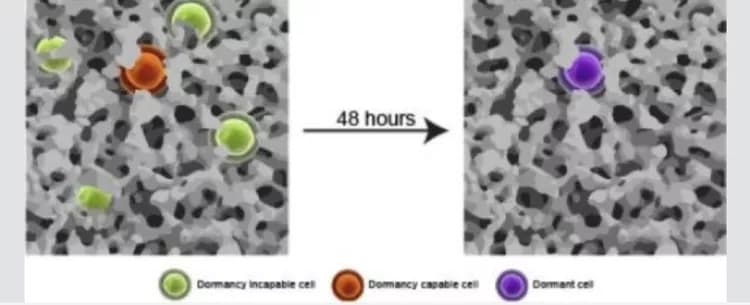
Novel Platform For Investigating Quiescence In Dormancy-Capable Cancer Cells
A team of researchers from the University of Minnesota-Twin Cities has reported a novel encapsulation approach in identifying dormant cancer cells and maintaining them in a quiescent state. Their method involves immobilizing cells within a rigid silica-PEG matrix that prevents movement and proliferation, thus imposing a selective stress on cells. Immobilization within the silica-PEG matrix was performed via a cytocompatible, sol-gel encapsulation method, creating a highly porous matrix with pores large enough to allow sufficient nutrient and gas diffusion to meet metabolic requirements but small enough to prevent cell movement and proliferation. These findings appear in the September 2017 issue of the journal TECHNOLOGY.
According to Alptekin Aksan, Ph.D., Professor of Mechanical Engineering at the University of Minnesota and senior author on this study, the validation of this model advances the field of study of tumor dormancy as "We know that certain metastases are caused by dormant cells, which are currently impossible to target. If we can isolate and study them, then we can develop ways to destroy them."
Dormant cancer cells undergo quiescent periods during cancer development during which they are not proliferative but remain alive. Due to their latent nature, they are unresponsive to chemotherapy and responsible for some cases of relapse. The difficulty in isolating these rare cells from patients has limited understanding of dormancy and the development of therapies to prevent cancer relapse. Aksan and his team showed in this study that stressing cells by immobilizing them in a manner where they cannot proliferate or move leads to a differential response between the cancer cell lines examined. A fraction of breast cancer cells that normally become dormant in vivo survived in the matrix for up to 3 weeks. In contrast, other breast cancer cells that are considered more aggressive forms of the disease did not survive in the matrix for more than 24 hrs. Additionally, researchers showed that noncancerous cells did not survive for long in the gel either. When cells were extracted from the matrix after 48 hours and returned to favorable growth conditions, cells resumed proliferation. The preservation of their proliferation potential confirmed that the cellular arrest was reversible as is observed in vivo.
The research team is expected to follow up on this study by using this platform to investigate dormancy in a variety of cancers, particularly those for which the biology of tumor dormancy remains poorly understood. "This technology is a good starting point for our studies modeling the biologic and mechanical effects of the tumor microenvironment on behavior of cells that become dormant in cancer patients. Our ultimate goal is to apply this technology in the clinic in order to better predict which individual patient's tumors will be more likely to become dormant, and as a result be more difficult to detect in this patient population," said Aksan. "We are working with physicians as clinical collaborators that provide this clinical perspective to our work."
Materials provided by World Scientific. Note: Content may be edited for style and length.
Disclaimer: DoveMed is not responsible for the accuracy of the adapted version of news releases posted to DoveMed by contributing universities and institutions.
References:
Julian Adolfo Preciado, Eduardo Reátegui, Samira M. Azarin, Emil Lou, Alptekin Aksan. (2017). Immobilization platform to induce quiescence in dormancy-capable cancer cells. TECHNOLOGY. DOI: 10.1142/S2339547817500078
Related Articles
Test Your Knowledge
Asked by users
Related Centers
Related Specialties
Related Physicians
Related Procedures
Related Resources
Join DoveHubs
and connect with fellow professionals

0 Comments
Please log in to post a comment.